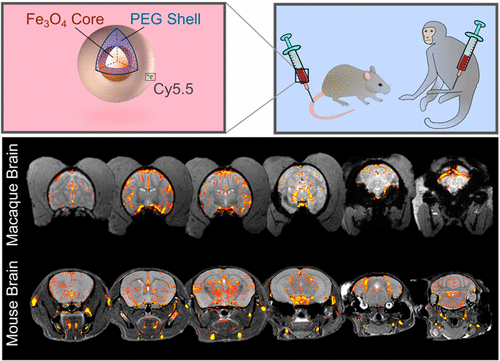Our official English website, www.x-mol.net, welcomes your
feedback! (Note: you will need to create a separate account there.)
Nanoparticle Biokinetics in Mice and Nonhuman Primates
ACS Nano ( IF 15.8 ) Pub Date : 2017-09-18 00:00:00 , DOI: 10.1021/acsnano.7b05377 Peter A. Chiarelli , Richard A. Revia , Zachary R. Stephen , Kui Wang , Mike Jeon , Veronica Nelson 1 , Forrest M. Kievit , Jonathan Sham , Richard G. Ellenbogen , Hans-Peter Kiem 1 , Miqin Zhang
ACS Nano ( IF 15.8 ) Pub Date : 2017-09-18 00:00:00 , DOI: 10.1021/acsnano.7b05377 Peter A. Chiarelli , Richard A. Revia , Zachary R. Stephen , Kui Wang , Mike Jeon , Veronica Nelson 1 , Forrest M. Kievit , Jonathan Sham , Richard G. Ellenbogen , Hans-Peter Kiem 1 , Miqin Zhang
Affiliation

|
Despite the preponderance of iron oxide nanoparticles (NPs) designed for theranostic applications, widespread clinical translation of these NPs lags behind. A better understanding of how NP pharmacokinetics vary between small and large animal models is needed to rapidly customize NPs for optimal performance in humans. Here we use noninvasive magnetic resonance imaging (MRI) to track iron oxide NPs through a large number of organ systems in vivo to investigate NP biokinetics in both mice and nonhuman primates. We demonstrate that pharmacokinetics are similar between mice and macaques in the blood, liver, spleen, and muscle, but differ in the kidneys, brain, and bone marrow. Our study also demonstrates that full-body MRI is practical, rapid, and cost-effective for tracking NPs noninvasively with high spatiotemporal resolution. Our techniques using a nonhuman primate model may provide a platform for testing a range of NP formulations.
中文翻译:

小鼠和非人类灵长类动物的纳米生物动力学。
尽管设计用于诊断学应用的氧化铁纳米颗粒(NPs)占优势,但这些NPs的广泛临床翻译仍然落后。需要更好地了解小动物模型和大动物模型之间NP药代动力学的变化,以快速定制NP以在人类中获得最佳性能。在这里,我们使用无创磁共振成像(MRI)跟踪体内大量器官系统中的氧化铁NP 。以研究小鼠和非人类灵长类动物的NP生物动力学。我们证明,小鼠和猕猴在血液,肝脏,脾脏和肌肉中的药代动力学相似,但在肾脏,大脑和骨髓中却不同。我们的研究还表明,全身MRI在高时空分辨率下以无创方式跟踪NP是实用,快速且具有成本效益的。我们使用非人类灵长类动物模型的技术可能为测试一系列NP制剂提供平台。
更新日期:2017-09-18
中文翻译:

小鼠和非人类灵长类动物的纳米生物动力学。
尽管设计用于诊断学应用的氧化铁纳米颗粒(NPs)占优势,但这些NPs的广泛临床翻译仍然落后。需要更好地了解小动物模型和大动物模型之间NP药代动力学的变化,以快速定制NP以在人类中获得最佳性能。在这里,我们使用无创磁共振成像(MRI)跟踪体内大量器官系统中的氧化铁NP 。以研究小鼠和非人类灵长类动物的NP生物动力学。我们证明,小鼠和猕猴在血液,肝脏,脾脏和肌肉中的药代动力学相似,但在肾脏,大脑和骨髓中却不同。我们的研究还表明,全身MRI在高时空分辨率下以无创方式跟踪NP是实用,快速且具有成本效益的。我们使用非人类灵长类动物模型的技术可能为测试一系列NP制剂提供平台。











































 京公网安备 11010802027423号
京公网安备 11010802027423号